In 2025, vertical gardens and living walls will be at the forefront of innovative landscaping, particularly commercial spaces. These techniques are transforming how businesses and urban developers integrate green spaces into built environments, offering aesthetic beauty and practical solutions for sustainability. From office buildings to hotels and urban public areas, vertical gardens and living walls reshape outdoor environments, reduce environmental footprints, and promote biodiversity.
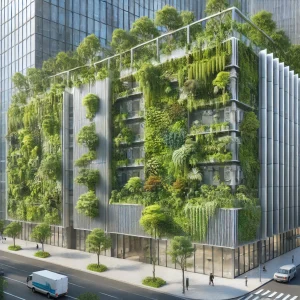
Vertical Gardens and Living Walls: A Brief Overview
Vertical gardens, or green walls, involve growing plants vertically, usually supported by structures attached to walls. Living walls take this concept further by integrating plants directly into building systems, sometimes even using advanced irrigation and climate control technology. Both techniques allow for greenery in spaces where horizontal gardens aren’t feasible, making them perfect for urban areas with limited ground space.
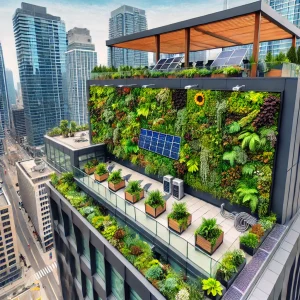
Environmental Benefits
There are numerous environmental advantages to vertical gardens and living walls. These systems help with air purification by absorbing carbon dioxide and releasing oxygen, a crucial benefit in urban environments with high pollution levels. They also act as natural insulation, reducing the need for artificial heating and cooling, thus contributing to energy conservation.
Water conservation is another key benefit. Advanced irrigation systems, often integrated into these walls, use water efficiently, recycling and reusing it where possible. Living walls can also help manage stormwater runoff, reducing flooding risks by absorbing rainwater.
Moreover, these vertical structures provide pollinators, insects, and bird habitats, enhancing biodiversity in dense urban settings.
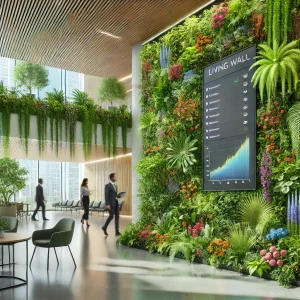
Examples from British Columbia
British Columbia, known for its commitment to sustainability, has quickly adopted vertical gardens and living walls in commercial landscaping. IslandEarth Landscape, a leader in the field, has implemented several notable projects focusing on bringing nature into urban spaces while promoting sustainability.
One example is IslandEarth’s work on office complexes in Victoria, where living walls are integrated with building structures to promote energy efficiency and provide employees with a natural, soothing environment. These installations improve the building’s ecological footprint and enhance its aesthetic appeal, creating a green oasis in the middle of the city.
Other companies in British Columbia are following suit. Large hotels incorporate living walls into their designs, often in lobbies and outdoor courtyards, to provide guests with a refreshing connection to nature. These walls also play a role in the branding of these hotels, signalling a commitment to eco-friendly practices.
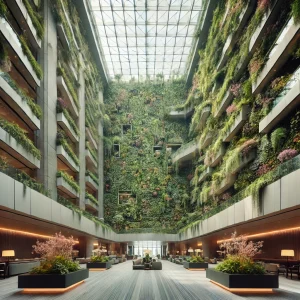
Comparing 2025 to Previous Years
Vertical gardens and living walls have been growing in popularity for over a decade, but 2025 marks a turning point in the technology and scale of their implementation. These gardens were often considered luxury add-ons in the past, but as the demand for sustainable urban solutions has increased, their integration into commercial spaces has become more widespread and affordable.
One key development in recent years has been the advancement of automated irrigation systems. These systems monitor soil moisture and weather conditions, ensuring plants receive the necessary water. In 2025, many vertical gardens will be designed with smart technology, enabling remote monitoring and maintenance.
Additionally, the materials used in constructing these gardens have evolved. Recycled and sustainable materials are now the standard, making these installations more eco-friendly and in line with broader efforts to reduce construction waste.
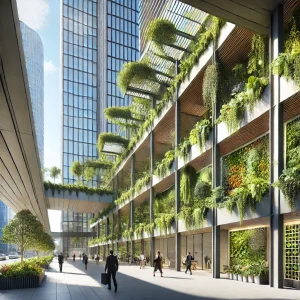
Potential Challenges: Maintenance and Cost
While the benefits of vertical gardens and living walls are undeniable, they come with challenges, particularly in maintenance and cost. These installations require regular upkeep to ensure plant health and the system’s longevity. Irrigation systems must be monitored and occasionally repaired, while the plants themselves require trimming, replacement, and protection from pests.
Costs can also be a barrier for some businesses. The initial investment for a living wall, including installation and irrigation, can be high. However, many companies are starting to see the long-term benefits, such as energy savings and enhanced property value, which often outweigh the upfront costs.
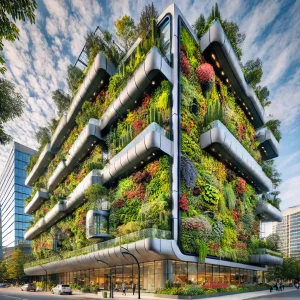
Looking Beyond 2025: The Future of Vertical Gardens and Living Walls
The future of vertical gardens and living walls is promising. As the technology behind these systems continues to evolve, we can expect more efficient, self-sustaining gardens. Innovations in plant biotechnology may soon allow for even more resilient plant species that require less water and care.
Additionally, as urbanization intensifies, the demand for these green solutions will only increase. Future projects may see entire buildings wrapped in living walls as an environmental necessity and a core part of architectural design.
In 2025, vertical gardens and living walls will no longer be niche elements in landscaping—they will be essential tools for creating sustainable commercial spaces. With benefits from environmental conservation to aesthetic enhancement, they transform urban landscapes, particularly in forward-thinking regions like British Columbia. As we move into the future, these techniques will continue to evolve, offering even more innovative ways to bring nature into our cities.
The time has never been better for businesses looking to invest in green solutions. The advancements in 2025, particularly in terms of technology and affordability, make vertical gardens and living walls practical and beneficial investments for the long term.